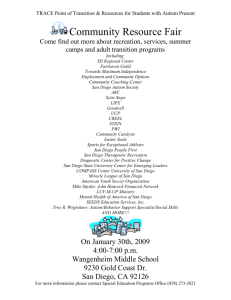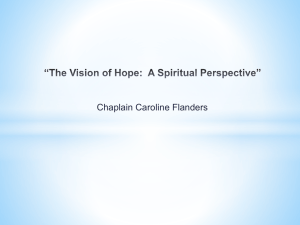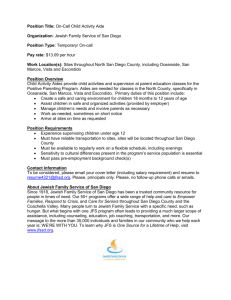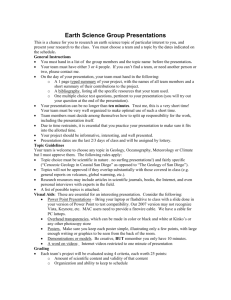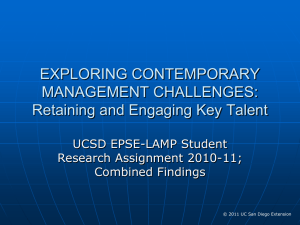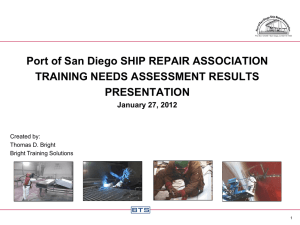San Diego`s Barrio Logan
advertisement
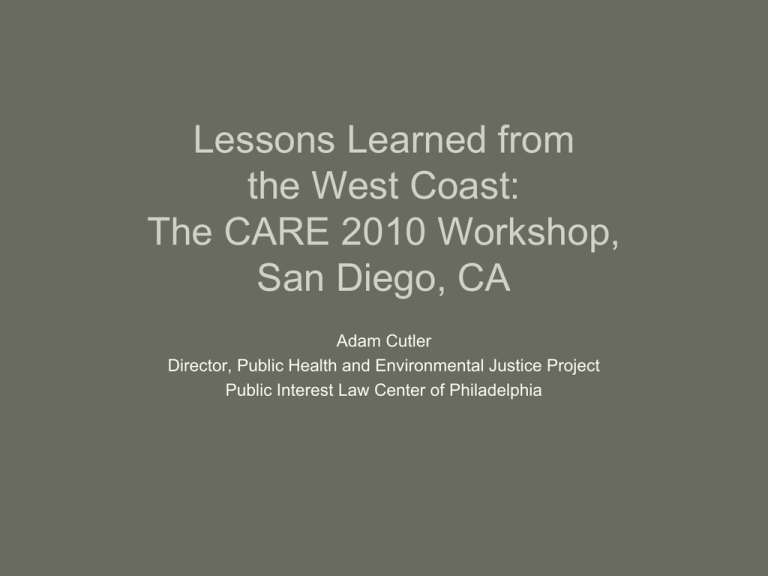
Lessons Learned from the West Coast: The CARE 2010 Workshop, San Diego, CA Adam Cutler Director, Public Health and Environmental Justice Project Public Interest Law Center of Philadelphia Our CARE Level 1 Project • Chester Environmental Partnership – Project Goals – Strengthen existing group and build membership by filling in gaps – Hire full time administrator to lead day to day operations – Build capacity within the organization (incorporation, website) and in the community (outreach to youth, seniors, and other residents) – Engage in the CARE Process – convene multi-sector discussions on Chester’s environmental risks; engage community stakeholders to rank those risks; and develop consensus on 3-5 risk reduction strategies to carry forward to implementation in Level 2. Lessons Learned – San Diego San Diego's Barrio Logan Low-income Latino neighborhood struggling with mixed-use zoning. Located between interstate highway and San Diego's port and waterfront industries. Metal plating company with100+ environmental violations (Chromium-6), located next door to homes. The facility was closed, cleaned up, and now houses a non-polluting business. Lessons Learned – San Diego San Diego's Barrio Logan Succeeded in advocating for new park to be built, reconnecting Barrio Logan with its former waterfront ties. Preserved historic Chicano Park, built by residents in protest under pilings of interstate/bridge to affluent Coronado Island. Lessons Learned – San Diego Old Town National City Latino community overburdened by auto body shops, creating air pollution, toxic releases, and runoff. One body shop is directly across street from elementary school. Asthma rates among children are 14%, double the CA state average. Successfully advocated for passage of "amortization ordinance" to phase out body shops near the most sensitive uses. Implementation coming soon. Restored algae choked stream to natural contours; wildlife soon returned and school uses as educational experience. Lessons Learned – Los Angeles Green Zones and the City Project • Green Zones – City Council just passed – Create special districts to attract clean industries through incentives, including help obtaining permits and tax and utility rebates. – Polluters, meanwhile, would be targeted with tougher inspection and enforcement protocols. – Using municipal planning and enforcement to address cumulative impacts (metal plating, body shops, freeways, heavy industry, etc.) – Seeking to create sustainable and healthy communities rather than fighting one facility after another. • City Project – Access to Parks – – – – Mapping park locations and income levels, minority populations Advocacy for new parks near/in underserved communities Broke ground on new park, construction still in progress Now bringing lessons learned in L.A. to San Diego Lessons Learned - Brooklyn • UPROSE – United Puerto Rican Organization of Sunset Park • Elizabeth Yeampierre, Executive Director, spoke to us about the importance of intergenerational programs in UPROSE’s Environmental Justice work • Engage youth in the community, both to help accomplish short-term goals and to build leadership talent for the future. Lessons on the West Coast A presentation for the Consortium for Community-Based Science A report from T.H.E. Impact Conference on Trade, Health and the Environment T.H.E. Impact Project On Trade, Health and Environment • Collaboration of community and university partners • Focused on reducing the impacts of trade, ports and goods movement activities on health and community life • Community-organizing approach to science New Scientific Findings Frank Gilliland, MD, PhD. Professor, Department of Preventive Medicine, Keck School of Medicine, USC Director, Southern California Environmental Health Sciences Center 2010 Clean Air Hero “By enhancing understanding of preventable public health impacts from polluted air, Dr. Gilliland’s work has helped provide a clearer assessment of the significant public health benefits that can be achieved in the greater South Coast region through cleaner goods movement operations, reduced vehicle miles traveled, and low-emission transportation investments.” New Scientific Findings Goods Movement: A Gateway for Health or Harm? A National Landscape Study of Freight Transport, Health, Organizing , Advocacy and Policy Los Angeles Riverside Kansas Detroit Community Outreach and Education, Southern California Environmental Health Sciences Center University of Southern California Trends in the Goods Movement Industry Trends in the Goods Movement Industry Trends in the Goods Movement Industry Trends in the Goods Movement Industry Openings and Challenges for Change • Federal Transportation Reauthorization Bill/SAFETEA-LU. The Freight Act of 2010 and the Clean Ports Act of 2010. • National Environmental Justice Advisory Committee Report • Interagency Task Force on Environmental Justice Recommendations • Connect Local Organizing to Regional Organizing • Strengthen National network • Community-university partnerships. • Incorporate health and environmental assessment into goods movement planning and project approval. • Increase local government capacity to regulate and plan • Build the movement Cumulative Impacts, Planning and Policy Decisions o Consider cumulative impacts o Take into account social vulnerability o Promote community participation o Take meaningful action Using the Clean Air Act • EPA is "for the first time ever… working to prevent short-term exposures in high-risk NO2 zones like urban communities and areas near roadways." Thank you for listening – Any questions?





